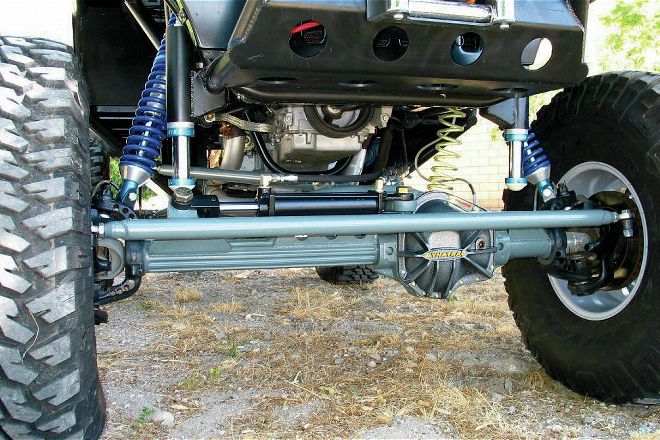
 John Cappa
Former Editor, Four Wheeler
John Cappa
Former Editor, Four Wheeler
Q: First, thanks for all that you have done to help us who are trying to get a clue about the world of off-road. I started with a 1993 YJ on 33-inch tires and have moved up to a 4.0L TJ with 36-inch tires. I eventually want to upgrade to 38-inch tires. I’ve learned a lot along the way, and I am taking my first welding class next month!
My Jeep has a Currie low-pinion 9-inch front axle with TJ Dana 30/44 knuckles. The rear axle is a high-pinion Currie 9-inch. I read in “Fullsize Invasion 3” (Sept. 201414) that you upgraded from a Dana 44 rearend to a Ford 9-inch on your J2000. I’ve been told the current Currie 9-inch front low-pinion and rear high-pinion setup is not the best to be chasing my friends around the Hammers, and I’m desperate for more information.
Currie says the high-pinion version is used to improve driveline angle and to get the driveshaft away from rocks. It’s rated to be used with no bigger than 35-inch tires in a rear application.
I’ve read that moving to a low-pinion third member in the rear will increase the strength by allowing the ring-and-pinion to drive on the stronger side of the gear teeth. What’s your take on using a 9-inch for a rearend that’s going to bounce over rocks? My friends are trying to get me to swap the rear for a 14-bolt with a shave kit. A True Hi9 sounds tempting, but I’m not sure if that would help as I’ve been told the axletubes are weak.
Alfred Ricci
Via email
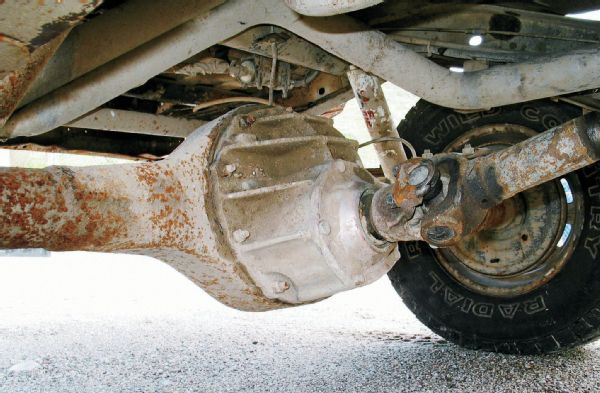
A: Since you already have the 9-inch rear housing, the 14-bolt option doesn’t make much sense for the tire size you want to run. The 14-bolt is overkill in your application. It weighs a ton and will hang up on every rock you try to drive over, even when shaved. Plus, the driveshaft will hang down really low. It’s not a good plan. The Ford 9-inch housing is plenty sturdy for your Jeep.
With a standard low-pinion 9-inch third member in the rear axle, the driveshaft will hang too low, and you’ll likely beat it up in the rocks. If it were my Jeep, I would keep the current rear axlehousing and consider installing a True Hi9 (truehi9.com) third member and gearset and then beef it up with 35-spline axleshafts (these are both bolt-in modifications). I’d then take the leftover Currie third member and put it in the front axle. The weak point will be the front ‘shafts and steering U-joints, so I would recommend swapping in some custom RCV (rcvperformance.com) axleshafts. The company should be able to build what you need. With this combination, you get the pinions and both front and rear driveshafts out of the rocks. Also, the ring-and-pinions will be transmitting power on the stronger drive side of the gear teeth.
Q: I’m looking for an exhaust system for my 2011 GMC Sierra regular cab longbed 4x4 with a 5.3L V-8. It does not have cylinder deactivation. There are a couple of shops around my area that can make custom exhausts but they do not offer mandrel bending. I have installed a cold air intake, I just need the exhaust system to finish it up. I would really appreciate your help.
Tom Peters
Macungie, PA
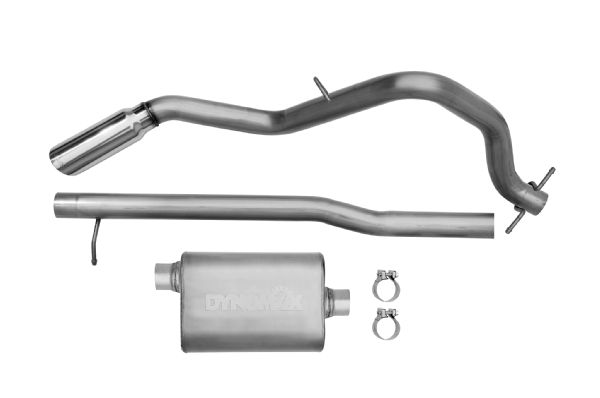
A: A free-flowing aftermarket exhaust will increase power and mpg in many applications such as yours. You’ll also be rewarded with a more throaty performance tone. There should be several companies that offer an cat-back exhaust system for your truck. Dynomax (dynomax.com) was the first place I checked. The company offers two different single 3-inch-diameter systems for your application. You have your choice of a kit with the Ultra-Flow welded muffler (PN 38497) or a kit with the VT muffler (PN 39497). Both of these kits are designed to fit ’09 to ’13 regular cab, longbed Chevrolet/GMC Silverado/Sierra 1500 trucks with the 4.8L or 5.3L. The Dynomax mufflers are 100 percent stainless steel and covered under a limited lifetime warranty. The exhaust tubing in both kits is mandrel bent for improved airflow.
Q: I have 1994 YJ with a straight-six and an automatic transmission. The automatic has its own cooler and fan on the wheelwell. I am running an electric fan on the radiator. While I didn’t have any overheating problems with the stock radiator, the old radiator has simply sprung several leaks, so I am looking to buy a new or rebuilt one. Any recommendations on the best radiator for the money for my application would be greatly appreciated. Are the aluminum radiators worth the extra money?
TAZ13
Via fourwheeler.com
A: As you have found, the stock radiators in most 4x4s will keep the engine cool unless more power or weight has been added to the vehicle, or something is wrong with the engine. However, some late-model radiators, like yours, are designed with crimp-on plastic radiator tanks. This can save a lot of weight over brass, and it’s less expensive and easier to manufacture than welded brass or aluminum tank radiators. Unfortunately, a lot of vibration and banging around can cause these plastic tanks to leak where they clamp to the core. For more abusive applications, or applications that see a lot of off-road use, it’s a good idea to use a full-brass or full-aluminum radiator. Aluminum is significantly lighter than brass, so if you are a stickler for weight, you can go that route. Rock Auto (rockauto.com) offers both plastic tank and full-metal radiators for your application. If you decide to go with aluminum, Flex-a-lite (flex-a-lite.com) offers an extremely efficient all-aluminum radiator that bolts into your Jeep. This radiator is also available with a built-in electric fan.
Q: I’m considering the purchase of a 1976 Jeep J-20. It runs, drives and is lifted with 40-inch tires. The tires and wheels alone are worth the asking price. The only hiccup is that the truck does not come with a title. What’s the safest way to move forward and purchase a vehicle without a title?
Katie Jansma
Via facebook.com/JohnCappa4x4
A:Older used 4x4s always come with a load of unknown baggage. You’ll often find things on the vehicle that don’t work, have been worn out, or poorly repaired. Registration is just as much of a gamble. You could end up with a vehicle that has back registration due or even parking fines attached to it. In some states, you can get stuck with these fees when you go to register the vehicle in your name. An unregistered vehicle leaves you open to this kind of problem and a vehicle with no title is an even bigger risk. Ultimately, you don’t know if the vehicle is actually owned by the person selling it to you; it could be a stolen vehicle. The last thing you want is for the police to knock on your door to confiscate your new-to-you 4x4. You’ll be out a car and the cash. It’s always a good idea to do a little extra research before buying a vehicle without a title. Jot down the license plate number and vehicle identification number (VIN). You should be able to take this information to the DMV to find out if it is stolen, has any back registration due, or has any unpaid fines attached to it. If the owner is willing, he/she can apply for a new title if it was simply lost. The DMV can help you with the paperwork. I’ve had really good luck registering oddball vehicles through AAA (aaa.com). As a member, you’ll save a ton of time by not having to wait in overly long DMV lines. AAA can process just about everything that the DMV can, only the people are usually much easier to work with, more understanding, and more friendly.
Q: I have a 1995 YJ with a four-cylinder. The rear driveshaft spins, but the Jeep does not move. I drove it home in four-wheel drive. Would you fix the Dana 35 or swap it?
I can get a pair of 1979 Ford Dana 60 axles for $400, and I have a set of 37-inch tires on military wheels. Will the four-cylinder be out-matched by this combo?
Mark Fosbinder
Via facebook.com/JohnCappa4x4
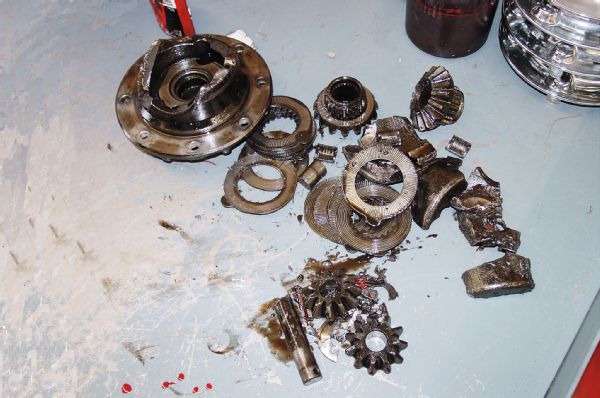
A: Personally, I would not put a dime into a Dana 35. Pull the diff cover and inspect the internals. It’s likely that it’s very busted up inside. If so, head to the wrecking yard or Craigslist, find a good used one with the correct gear ratio, and slap it in. A lot of people will disagree with my logic, but it’s just not a very good axle assembly and not worth the investment to upgrade it or reinforce it. I would not recommend installing a locker in a Dana 35. The housing flexes and causes differential, gear, and axleshaft issues. A 32-inch tire is the largest I would consider using with a Dana 35 rear axle. Are there people that get away with it? Of course! But it’s a time bomb waiting to go off.
Swapping to Dana 60s front and rear is a bit extreme. It’s a lot of weight to make up for. It really all depends on how you use the Jeep and if you truly NEED the 37s or just want to install them because you have them. If you go with the 37s, you’ll need to address some other issues such as lift and tire clearance, steering, driveshafts, brake lines, and so on.
A Cherokee XJ 8.25-inch rearend, a TJ Dana 44, or even a Ford Explorer 8.8 all make good Dana 35 swap candidates. All three can be swapped in relatively easily. The Cherokee 8.25-inch will likely be the easiest and most cost-effective swap. A used Cherokee 8.25-inch rearend can be had for a couple hundred bucks, about as much as a usable wrecking yard Dana 35. The most difficult part of that swap will be relocating the spring perches.
Q: I’m looking for a rear disc brake conversion kit for an 8-lug Dana 44 that I pulled out of a 1978 Scout. Do you know of a kit?
ahhorner86
Via fourwheeler.com
A: Unfortunately, the International Scout was never offered with 8-lug axles from the factory. Also, because it’s an eight-lug rear axle, it’s probably not a Dana 44. I’m guessing it’s a Dana 60. It’s more than likely that someone had swapped the axle into the Scout you took it from. Identifying the axle to locate a disc brake kit may be a difficult task. However, every Dana axle came with a bill of materials number that can be used to identify it. The manufacture date and the bill of materials numbers are stamped into the axletube to the right of the differential cover. Clean the housing and lightly sand the tube in this area to make the numbers legible. An overly corroded housing will be near impossible to identify.
TSM Manufacturing (tsmmfg.com) offers front and rear disc brake kits for many common and uncommon axles. The kits are available with or without calipers and with or without an E-brake. The TSM products we have used fit well and actually bolt-up better than many of the other kits we have seen in the aftermarket.
Q: In your opinion, can I make full hydraulic steering street-safe?
Chris Stewart
Via facebook.com/JohnCappa4x4
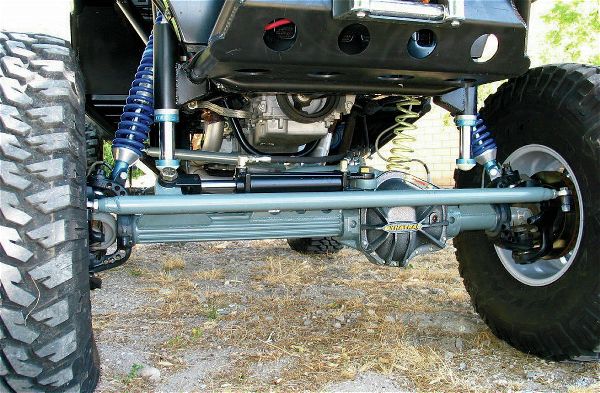
A: Full hydraulic steering has some unique advantages and unusual drawbacks. A full hydraulic steering system replaces the all of the mechanical linkages that connect the steering wheel to the front tires with a hydraulic control (orbital) valve, hoses, a large ram mounted to the axle, a pump, and hydraulic fluid. These systems generally require less steering effort because they provide more steering power than a traditional power steering box. Because of this, full hydraulic steering can be twitchy. It takes some getting used to off-road and can be a real handful on-road, especially if you don’t match the components properly. If you want to carry any kind of speed off-road, you’ll want to make sure that the orbital valve you choose is load sensing. This will help provide some steering feedback and help the wheels return to center when coming out of a corner.
Is it safe to run full hydraulic steering on the street? Some will argue that full hydraulic steering is not legal for street use, and that may be true in some states that require some sort of mechanical steering linkage. But the truth is there are a few factory vehicles on the road today that do not have mechanical steering linkages connecting the steering wheel to the tires. And as autonomous cars take to the streets, this will become even more ambiguous. Ultimately, if the system is well thought out and built using properly matched components with quality hoses, it can be used safely on the streets. Although, I generally would not recommend it because of the handling quirks and lack of a redundant backup if one of the hoses should fail. It’s simply not the kind of steering system you will be comfortable putting just anyone behind the wheel of. If you plan to use the vehicle on the street, you are better off with a ram-assist system that utilizes a steering box.
Have a 4x4 tech question you want answered in Techline, drop an email to editor@fourwheeler.com or head on over to our forums at fourwheeler.com. All letters become the property of Four Wheeler, and we reserve the right to edit them for length, accuracy, and clarity. Due to the volume of mail, electronic and otherwise, we cannot respond to every reader, but we do read everything.